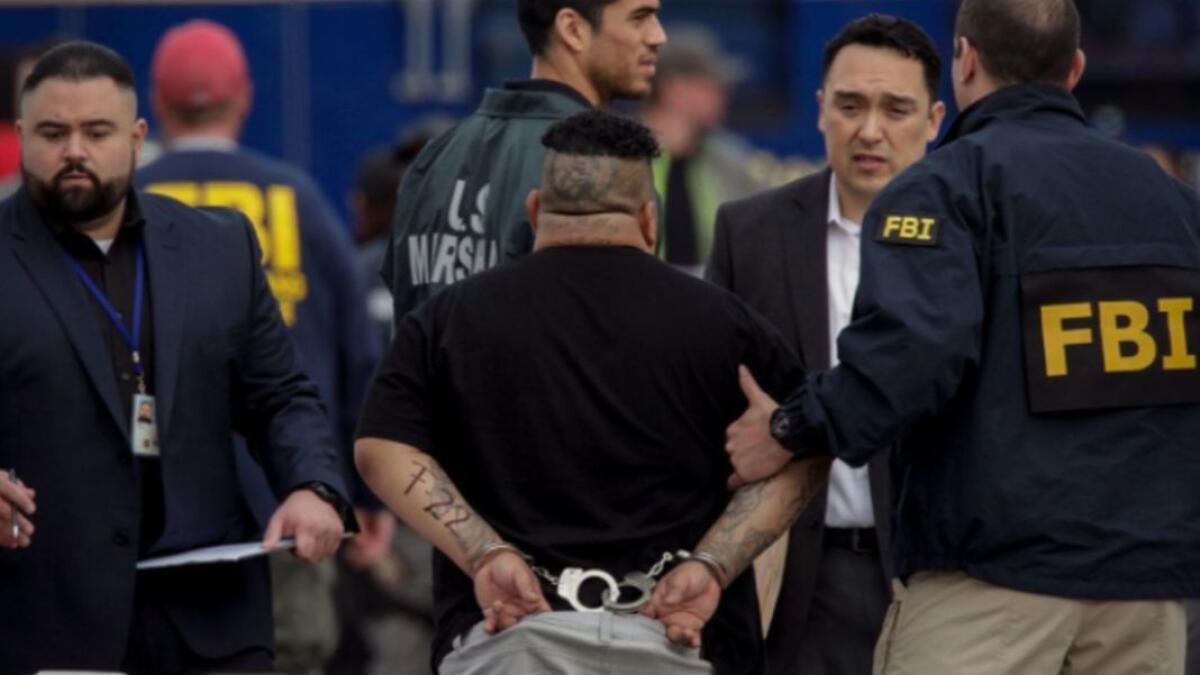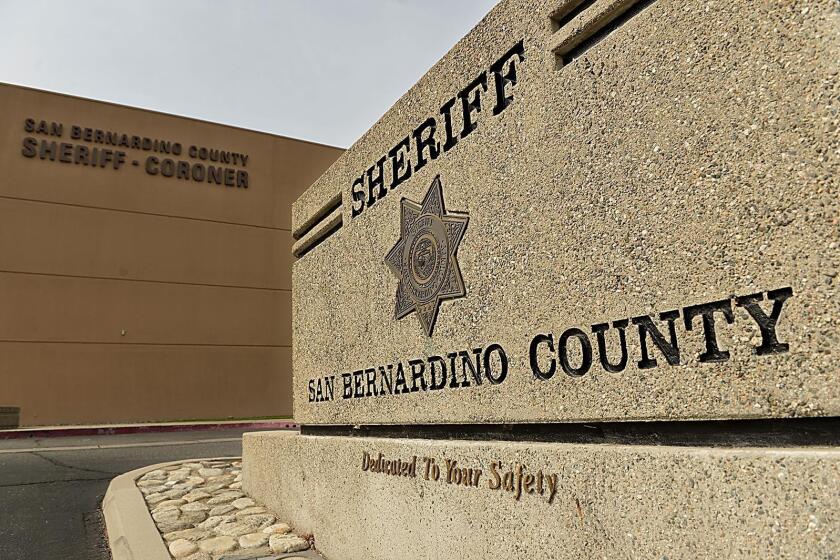Trump’s immigration war with California has reached a fever pitch

- Share via
Donald Trump and California have long been at odds on the issue of illegal immigration. The president wants to deport those who are here illegally, while many Californians and their leaders want to protect them.
But in the last month, this battle has reached a fever pitch.
Trump has said California police are soft on street gangs and suggested pulling federal immigration agents out of the state.
Immigration officials have vowed more sweeps because of state and local “sanctuary” laws aimed at shielding those who are here illegally.
The White House says the Justice Department is reviewing recent actions of Oakland’s mayor, who alerted residents about upcoming sweeps.
In the coming days, the president is expected to make his first trip to California since being elected to review prototypes for the controversial border wall he’s promised.
And now the Trump administration is suing the state over its sanctuary laws.
Here’s a primer from the pages of The Times:
What is the clash between the White House and Oakland’s mayor?
Last month, Oakland Mayor Libby Schaaf in an email gave residents of her city advance warning of an Immigration and Customs Enforcement raid.
That email outraged federal immigration officials and has sparked some type of “review” by the Justice Department.
“I think it’s outrageous that a mayor would circumvent federal authorities and certainly put them in danger by making a move such as that,” White House Press Secretary Sarah Huckabee Sanders told reporters last week.
Schaaf has defended her statement, saying she felt it was her duty to alert residents of the ICE action.
Oakland, like many California cities, has declared itself a “sanctuary” for those here illegally, and officials there have vowed to fight President Trump’s immigration crackdown.
Legal experts thought it was doubtful any charges would be filed against the mayor. But they said the dispute shows how charged the issue of immigration has become.
Harry Litman, a former U.S. attorney and deputy assistant attorney general who teaches at UC San Diego, said he was struck by the “the near-open warfare between the local and federal authorities.”
“Normally the federal government takes the lead and the state authorities follow in these sorts of things,” he said. Now, “you have essentially an almost guerrilla movement by local authorities to try and undo federal law enforcement efforts.”
Charges against the mayor “would be extraordinary,” he said.
Oakland has also pushed back against the ways law enforcement, through new technology and shared databases, collects personal information, images and communications of criminal suspects and innocent bystanders alike.
Formed in January 2016, the Oakland Privacy Advisory Commission has worked to ensure those surveillance tools aren’t used to target immigrant or Muslim communities.
Could Trump pull immigration officers out of California?
Last month, Trump did discuss the idea, in passing.
“I mean, frankly, if I wanted to pull our people from California, you would have a crime mess like you’ve never seen in California,” Trump said. “You’d be inundated. You would see crime like no one’s ever seen crime in this country. And yet we get no help from the state of California. They’re doing a lousy management job, they have the highest taxes in the nation, and they don’t know what’s happening out there.”
There has been no further talk about withdrawing agents. And the Bay Area raids that the Oakland mayor warned about happened the next week.
Trump also accused California law enforcement agencies of being soft on street gangs, prompting a strong rebuke from local officials who said the president doesn’t understand their war on gangs.
How about the immigration sweeps?
In fiscal year 2017, ICE arrested 20,201 people across the state, officials said. Of those, 81% had criminal convictions, they said. Still, dozens had no criminal histories. Although the raids prioritized people who pose a threat, officials said, anyone violating immigration laws was subject to arrest.
Besides the Bay Area enforcement action, several sweeps have taken place in Southern California.
In February in the Los Angeles area, more than 100 people were arrested “who pose a threat to national security, public safety and border security,” ICE said.
What about Trump’s war on ‘sanctuary cities’?
Numerous cities in California have declared themselves sanctuaries for those here illegally. Many of these sanctuary cities existed before Trump was elected president.
Now they have become a flash point in the debate, and none more than San Francisco.
Last year. the White House cited San Francisco’s sanctuary policies in the slaying of Kate Steinle, a young woman who was fatally shot by a man in this country illegally.
Steinle was shot in the back in July 2015 as she walked with her father on Pier 14, in the heart of the city’s tourist district. Less than an hour later, Jose Ines Garcia Zarate, a seven-time felon who had been deported from the U.S. to Mexico numerous times, was arrested about a mile away. He was soon charged in the killing.
In March 2015, when Garcia Zarate finished his third federal prison term for felony reentry into the United States from Mexico, he was turned over to San Francisco on a decades-old bench warrant for alleged marijuana possession. Prosecutors declined to file charges. ICE asked to be notified prior to his release, but city officials did not comply because Garcia Zarate did not meet their sanctuary city criteria, set in 2013, for turning over people to immigration officials. He was freed.
Last December, Garcia Zarate was found not guilty. The trial hinged on whether jurors believed the killing was intentional or accidental, as the defense asserted.
City officials have said it is preposterous to blame sanctuary laws for the killing.
There is no neat definition of a sanctuary city, but in general, cities that identify with the label seek to offer political support or practical protections to people who are in the country illegally.
For some cities, the sanctuary movement consists simply of encouraging people without legal status to get more involved in government.
Other places, including San Francisco, adopt far-reaching policies, such as taking steps to cut ties with federal immigration officials and refusing to fully cooperate with them.
San Francisco declared itself a sanctuary city in 1989, and city officials strengthened the stance in 2013 with its Due Process for All ordinance. The law declared that local authorities could not detain immigrants for federal immigration officials if the immigrant had no violent felonies on their record and did not currently face charges.
Trump often railed against sanctuary policies during the campaign, and a crackdown on sanctuary jurisdictions was one of his first actions as president. Cities fought back with court challenges, and federal judges in San Francisco and Chicago have issued rulings that sharply limited the administration’s attempt to tie grant funds to cooperation with immigration enforcement.
What about California’s sanctuary state law?
California passed its own sanctuary laws, and that is now at the heart of the latest clash.
The Trump administration went to federal court Tuesday to invalidate three California sanctuary laws.
Administration officials say the three laws in question, all passed by the Legislature last year, blatantly obstruct federal immigration law and thus violate the Constitution’s supremacy clause, which gives federal law precedence over state measures.
The laws make it a crime for business owners to voluntarily help federal agents find and detain undocumented workers, prohibit local law enforcement from alerting immigration agents when detainees are released from custody, and create a state inspection program for federal immigration detention centers.
Administration officials charge that the state measures not only hinder their ability to carry out federal law, but also put immigration agents and communities at risk.
The suit includes a declaration from ICE’s acting director, Thomas Homan, who said that the inability of officers to go to local lockups to pick up immigrants who have been detained by local police agencies forces them to hunt down suspects in more dangerous settings.
SB 54, one of the three challenged state laws, prohibits state and local police agencies from notifying federal officials in many cases when immigrants potentially subject to deportation are about to be released from custody.
When the law was under consideration in the Legislature, former U.S. Atty. Gen. Eric H. Holder Jr., who now represents the state Senate, wrote a letter defending the measure’s constitutionality. The federal government has the authority to enforce its immigration laws, but doesn’t have the power to draft California officials into helping, he said.
On Wednesday, U.S. Atty. Gen. Jeff Sessions accused the state of impeding federal immigration officials from doing their jobs and said he would use every power he had to stop it.
Speaking in Sacramento at an annual Law Enforcement Legislative Day held by the California Peace Officers’ Assn., Sessions once more took shots at Oakland’s Schaaf for warning residents about the ICE raids, and at Lt. Gov. Gavin Newsom for praising her actions.
More than 100 police chiefs, sheriffs and other law enforcement officers welcomed Sessions to the event at a Sacramento hotel with applause. Outside, members of a statewide coalition of immigrant rights groups gathered to protest his appearance.
California Democratic leaders and the state’s top law enforcement officer responded with warlike rhetoric of their own.
“This is basically going to war against the state of California,” said Gov. Jerry Brown.
“Let’s face it, the Trump White House is under siege,” Brown said. “Obviously, the attorney general has found it hard just to be a normal attorney general. He’s been caught up in the whirlwind of Trumpism … [and is] initiating a reign of terror.”
UPDATES:
2:45 p.m.: This article was updated with information about the Oakland Privacy Advisory Commission.
12:15 p.m.: This article was updated with new comments from Brown.
11:10 a.m.: This article was updated with details of Atty. Gen. Jeff Sessions’ appearance Wednesday in Sacramento..
This article was originally posted at 9:10 a.m.











